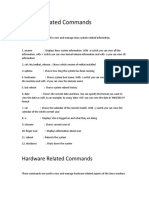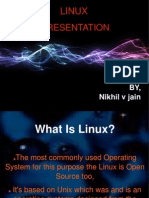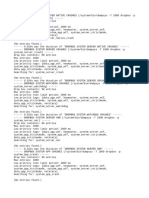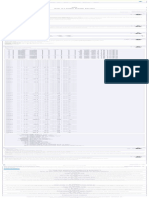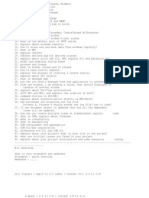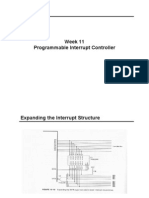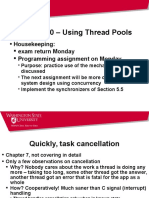0 ratings0% found this document useful (0 votes)
9 views2) Linux Configuration and Basic Commands
Uploaded by
areekasourcerCopyright
© © All Rights Reserved
Available Formats
Download as PDF, TXT or read online on Scribd
0 ratings0% found this document useful (0 votes)
9 views2) Linux Configuration and Basic Commands
Uploaded by
areekasourcerCopyright
© © All Rights Reserved
Available Formats
Download as PDF, TXT or read online on Scribd
You are on page 1/ 7
Linux Commands You Must
Know as a cloud Engineer
01. ls — The most frequently used command in Linux to list directories
02. pwd — Print working directory command in Linux
03. cd — Linux command to navigate through directories
04. mkdir — Command used to create directories in Linux
05. mv — Move or rename files in Linux
06. cp — Similar usage as mv but for copying files in Linux
07. rm — Delete files or directories
07. touch — Create blank/empty files
07. ln — Create symbolic links (shortcuts) to other files
08. cat — Display file contents on the terminal
09. clear — Clear the terminal display
10. echo — Print any text that follows the command
11. less — Linux command to display paged outputs in the terminal
12. man — Access manual pages for all Linux commands
13. uname — Linux command to get basic information about the OS
14. whoami — Get the active username
15. tar — Command to extract and compress files in Linux
16. grep — Search for a string within an output
17. head — Return the specified number of lines from the top
18. tail — Return the specified number of lines from the bottom
19. diff — Find the difference between two files
20. cmp — Allows you to check if two files are identical
21. comm — Combines the functionality of diff and cmp
22. sort — Linux command to sort the content of a file while outputting
23. export — Export environment variables in Linux
24. zip — Zip files in Linux
25. unzip — Unzip files in Linux
25. ssh — Secure Shell command in Linux
26. service — Linux command to start and stop services
27. ps — Display active processes
28. kill and killall — Kill active processes by process ID or name
29. df — Display disk filesystem information
30. mount — Mount file systems in Linux
31. chmod — Command to change file permissions
32. chown — Command for granting ownership of files or folders
33. ifconfig — Display network interfaces and IP addresses
34. traceroute — Trace all the network hops to reach the destination
35. wget — Direct download files from the internet
36. ufw — Firewall command
37. iptables — Base firewall for all other firewall utilities to interface with
38. apt, pacman, yum, rpm — Package managers depending on the distro
39. sudo — Command to escalate privileges in Linux
40. cal — View a command-line calendar
41. alias — Create custom shortcuts for your regularly used commands
42. dd — Majorly used for creating bootable USB sticks
43. whereis — Locate the binary, source, and manual pages for a command
44. whatis — Find what a command is used for
45. top — View active processes live with their system usage
46. useradd and usermod — Add new user or change existing users data
47. passwd — Create or update passwords for existing users
48. ls -1 | wc -l — Command to get the count of the files present into
directory.
49. kill --Command to kill the process (PID)
50. w -- to check how many users logged into the linux
51. date -- used to check the current date, time in linux
52. ls -a --List the hidden files in directory (hidden files are denoted as ..)
53. ls -l --Use to check the permissions on all the files
54. ls -R -- used to list information about files and directories within the file
system.
55. rm -rf -- remove directory with the files
You might also like
- How To Do SAP System Copy Step-By-step Post Processing100% (1)How To Do SAP System Copy Step-By-step Post Processing14 pages
- Top 50+ Linux Commands You MUST Know - DigitalOceanZZZNo ratings yetTop 50+ Linux Commands You MUST Know - DigitalOceanZZZ45 pages
- Session-1: 50 Most Useful Linux Commands: Category-1: File System ManagementNo ratings yetSession-1: 50 Most Useful Linux Commands: Category-1: File System Management6 pages
- 35 Linux Basic Commands Every User Should KnowNo ratings yet35 Linux Basic Commands Every User Should Know8 pages
- 38 Basic Linux Commands To Learn With Examples: SyntaxNo ratings yet38 Basic Linux Commands To Learn With Examples: Syntax18 pages
- Linux Command Cheat Sheet With 100 Commonly Used CommandsNo ratings yetLinux Command Cheat Sheet With 100 Commonly Used Commands6 pages
- Top 50+ Linux Commands You MUST Know - DigitalOceanNo ratings yetTop 50+ Linux Commands You MUST Know - DigitalOcean42 pages
- "Linux Commands": Diploma in Computer EngineeringNo ratings yet"Linux Commands": Diploma in Computer Engineering8 pages
- Basic50linuscommand 100602035730 Phpapp02No ratings yetBasic50linuscommand 100602035730 Phpapp0211 pages
- What Disk Image Should I Use With VirtualBoxNo ratings yetWhat Disk Image Should I Use With VirtualBox2 pages
- Dell Open Print Driver: MSI Install Command Line Options Lockdown PoliciesNo ratings yetDell Open Print Driver: MSI Install Command Line Options Lockdown Policies25 pages
- Red - Hat.pass4sure - Ex200.dumps.2023 Jan 08.by - Hugh.73q.vceNo ratings yetRed - Hat.pass4sure - Ex200.dumps.2023 Jan 08.by - Hugh.73q.vce14 pages
- How To Recover CHKDSK Orphaned File To Fix Ruined DriveNo ratings yetHow To Recover CHKDSK Orphaned File To Fix Ruined Drive9 pages
- ONAP - Open Network Automation PlatformNo ratings yetONAP - Open Network Automation Platform22 pages
- Mod Menu Log - Com - Storytaco.darlingpetNo ratings yetMod Menu Log - Com - Storytaco.darlingpet58 pages
- D1T2 - Mark Dowd & Tarjei Mandt - iOS6 SecurityNo ratings yetD1T2 - Mark Dowd & Tarjei Mandt - iOS6 Security71 pages
- Basic Unix and Linux Commands With ExamplesNo ratings yetBasic Unix and Linux Commands With Examples168 pages
- What You Will Need:: Follow The Instructions Here Tuxboot ClonezillaNo ratings yetWhat You Will Need:: Follow The Instructions Here Tuxboot Clonezilla2 pages
- How To Do SAP System Copy Step-By-step Post ProcessingHow To Do SAP System Copy Step-By-step Post Processing
- Top 50+ Linux Commands You MUST Know - DigitalOceanZZZTop 50+ Linux Commands You MUST Know - DigitalOceanZZZ
- Session-1: 50 Most Useful Linux Commands: Category-1: File System ManagementSession-1: 50 Most Useful Linux Commands: Category-1: File System Management
- 38 Basic Linux Commands To Learn With Examples: Syntax38 Basic Linux Commands To Learn With Examples: Syntax
- Linux Command Cheat Sheet With 100 Commonly Used CommandsLinux Command Cheat Sheet With 100 Commonly Used Commands
- Top 50+ Linux Commands You MUST Know - DigitalOceanTop 50+ Linux Commands You MUST Know - DigitalOcean
- Dell Open Print Driver: MSI Install Command Line Options Lockdown PoliciesDell Open Print Driver: MSI Install Command Line Options Lockdown Policies
- Red - Hat.pass4sure - Ex200.dumps.2023 Jan 08.by - Hugh.73q.vceRed - Hat.pass4sure - Ex200.dumps.2023 Jan 08.by - Hugh.73q.vce
- How To Recover CHKDSK Orphaned File To Fix Ruined DriveHow To Recover CHKDSK Orphaned File To Fix Ruined Drive
- D1T2 - Mark Dowd & Tarjei Mandt - iOS6 SecurityD1T2 - Mark Dowd & Tarjei Mandt - iOS6 Security
- What You Will Need:: Follow The Instructions Here Tuxboot ClonezillaWhat You Will Need:: Follow The Instructions Here Tuxboot Clonezilla










